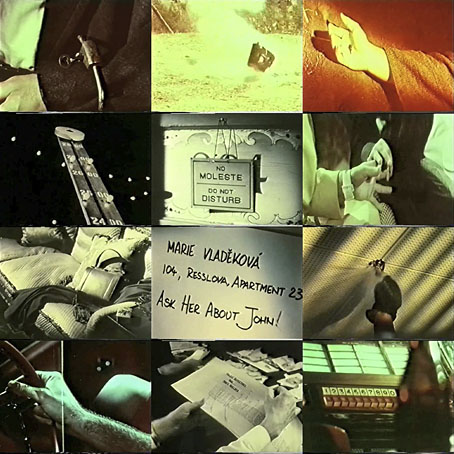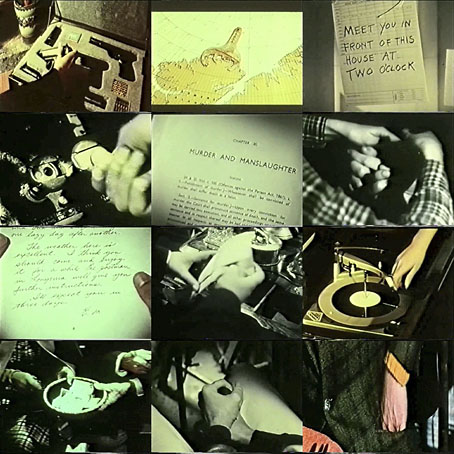Here’s a good one for enthusiasts of cinematic formalism. () (2003) is a 20-minute soundless assembly by Morgan Fisher of isolated moments from many feature films:
() is made up entirely of “inserts” from feature films organized according to Oulipian principles. Inserts were usually shot by assistants when star actors, large crews, or expensive sets were not needed. These include details of weapons, wounds, letters, signs, tombstones, machinery, games of chance, timepieces, money, and even intimate caresses. Fisher culled the inserts from a number of films he collected for that purpose and edited them together under constraints he does not fully reveal; he places the inserts from a given film in the order in which they appeared in that film, but two inserts from the same film never follow each other directly in his assemblage. Alternating among them we catch glimpses of violence, intrigue, high-stakes gambling, and sexual adventure.
Morgan Fisher is an expert musical collagist as well as a notable anthologist. His Miniatures (1980) anthology is a particular favourite, being a collection of one-minute recordings by a host of different artists. () is the first of his films that I’ve seen, however. The idea is superficially similar to Christian Marclay’s recent The Clock (2010), although Marclay’s concept is rendered more audience-friendly by sticking to a single theme which requires little explanation.
Both works remind me that some years ago I spent two weeks labouring with a pair of video recorders and a huge stack of tapes to collage together three hundred separate clips from famous films. The resulting 15-minute piece was intended as a visual complement to Holger Czukay’s Hollywood Symphony, the last track on his Movies (1979) album. That collage seemed impressive at the time, mostly because the effort required to produce anything decent via such crude methods was considerable. In the age of non-linear editing and YouTube supercuts few people would be impressed at all. I did send a copy of the video to Holger Czukay, however, and received a pleasant phone call by way of thanks. I still relish that.
Morgan Fisher’s () can be seen at Ubuweb. Fisher writes about the Miniatures tracks in great detail on his blog.
Previously on { feuilleton }
• La Région Centrale
• Downside Up



Even though editing as an art medium is pretty old (Cornell’s Rose Hobart is from 1936), it is not ‘transparent’, i.e. I find that people are still hit by the ‘novelty’ of it. Audiences seem to respond to the technique more than what the artist is doing with it. At least that was my impression at Marclay’s screenings.
I think that’s because people are seldom presented with the structure of cinema in such a direct manner. Editing is an unusual thing. Martin Scorsese may see it as representative of the discontinuities of perception but I doubt many people regard their consciousness as being so continually fragmented. Film editing is one of those technical conventions that everyone accepts but few people outside filmmaking (or criticism) think about or even notice at all. Hence the surprise when it’s pushed to the foreground. It was a shock to people when Alain Resnais fragmented the structure of Muriel in 1963 with flash-cuts that seemed to have no connection to the content of the shots around them. That quickly became another accepted part of editing technique but for a while it was a radical step.